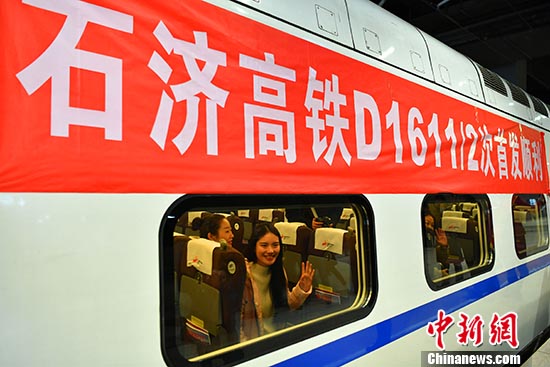
A high-speed passenger railway linking Hebei's provincial capital of Shijiazhuang and Jinan, capital of neighboring Shandong Province starts operation, Dec. 28, 2017. (Photo/China News Service)
(ECNS) -- A high-speed passenger railway linking Hebei's provincial capital of Shijiazhuang and Jinan, capital of neighboring Shandong Province, started operation on Thursday amid China's ongoing efforts to enhance its railway network.
The centerpiece of China's high-speed rail grid, known as "Four Vertical and Four Horizontal,” is composed of eight rail corridors, four running north-south and four east-west.
The Shijiazhuang-Jinan railway is part of a horizontal trunk line from western Taiyuan, capital of coal-rich Shanxi Province, to eastern Qingdao, a coastal city in Shandong.
The 319-kilometer railway, with a designed speed of 250 kilometers per hour, will shorten the current four-hour traveling time between Shijiazhuang and Jinan to one hour and twenty minutes. Construction started in August 2013.
The Shijiazhuang-Jinan link also means a high-speed railway connection among regions traditionally affected by the Yanshan Mountains and Taihang Mountains, making Shijiazhuang an important hub closely linked with Beijing, Tianjin, Dezhou in Shandong by high-speed trains.
In another development, as China Railway Corp. started the new timetable on Thursday, more high-speed trains now connect southwestern regions with Beijing, Tianjin and Hebei Province. It takes 7 hours and 47 minutes to travel from Chengdu City, capital of southwestern Sichuan Province, to Beijing by the country’s next generation bullet train "Fuxing,” cutting the time by half.
Tianjin, about 100 kilometers southwest of Beijing, also links Chengdu directly with a high-speed train for the first time in history.
"Fuxing" debuted on the Beijing-Shanghai line in June. The new bullet trains, also known as electric multiple units (EMU), boast top speeds of 400 kilometers per hour and a consistent speed of 350.
China has the world's longest railway network at 22,000 kilometers by the end of 2016, about 60 percent of the world's total.


















































